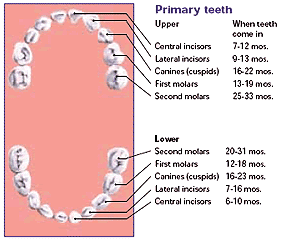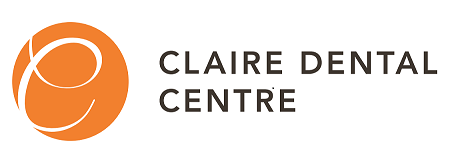Claire Dental Kids
We love kids at Claire Dental and they love us too! The Canadian Dental Association recommends the assessment of infants, by a dentist, within 6 months of the eruption of the first tooth or by one year of age. The goal is to have your child visit the dentist before there is a problem with his or her teeth. In most cases, a dental exam every six months will let us catch small problems early.
For more information about your child’s first dental visit: https://www.cda-adc.ca/en/oral_health/cfyt/dental_care_children/first_visit.asp
Come by with your tots for a clinic tour! Your toddler’s first impression of the dentist and clinics often sets the tone for their future dental visits. We will help your little ones have a positive experience by getting them acquainted with dental chairs and tools.
Dental Development
All twenty baby (or primary) teeth come in by the time your child is two or three years old.
Primary Teeth

This chart shows when baby teeth come in (or erupt) in most children.
If your child is getting his or her teeth and seems to be in pain, you can:
- Rub the gums with a clean finger, or
- Rub the gums with the back of a small, cool spoon.
- If your child is still unhappy, your dentist, pharmacist or doctor can suggest an over-the-counter medicine to ease the pain
Here’s what you should not do:
- Do not use the kind of painkiller that can be rubbed on your child’s gums. Your child may swallow it.
- Do not give your child teething biscuits. They may contain added sugar which can contribute to developing cavities.
- Do not ignore a fever. Getting new teeth does not make babies sick or give them a fever. If your child has a fever, check with your
doctor.
Permanent Teeth:

This chart shows when permanent teeth develop in most children.
At age six or seven, the first adult (or permanent) teeth come in. They are known as the “first molars” or the “six-year molars”.
They come in at the back of the mouth, behind the last baby (or primary) teeth. They do not replace any primary teeth.
Also at around age six, children start to lose their primary teeth. The roots slowly get weak, and the tooth falls out. Children lose primary teeth until they are about 12 years old.
It’s okay for children to wiggle their primary teeth if they are loose. But it’s not okay to use force to pull out a tooth that’s not ready to come out. When a tooth comes out at the right time, there will be very little bleeding.
Why do the new permanent teeth look yellow?
Permanent teeth often look more yellow than primary teeth. This is normal. But it could also be caused by medicine your child took, by an accident that hurt a primary tooth, or by too much fluoride. Ask your dentist about this when you go for a dental exam.
Healthy Gums
Cavities are the main problem children have with their teeth. But children can get gum disease too, just like adults. It happens when the gums that hold our teeth in place get infected.
Daily brushing and flossing can stop gum disease. If your child’s gums bleed, don’t stop brushing. If the gums are always swollen, sore or bleeding, there may be a serious problem. You should take your child to the dentist.
Dental Safety
Here are some ways to protect your child’s teeth:
- Always use infant car seats and seat belts when you drive.
- Babies will chew on almost anything. Keep them away from hard things that could crack their teeth.
- Children fall a lot when they are learning to walk. Teeth can break, crack, get knocked out or become loose. See your dentist if this happens.
If you have questions about your child’s teeth, talk to your dentist.
For more information about dental care for children, visit: https://www.cda-adc.ca/en/oral_health/cfyt/dental_care_children/development.asp
